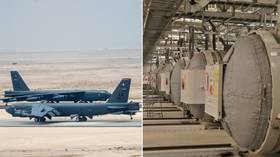Iran holds all the cards in coming Middle East conflict with US - unless Trump is ready to drop a tactical NUKE
Scott Ritter
is a former US Marine Corps intelligence officer. He served in the Soviet Union as an inspector implementing the INF Treaty, in General Schwarzkopf’s staff during the Gulf War, and from 1991-1998 as a UN weapons inspector.
6 Jan, 2020 12:04 / Updated 38 minutes ago

Iran has promised retaliation for the assassination of Qassem Suleimani. Donald Trump said this will lead to a disproportionate response from the US. One side can deliver on its threats, the other can’t, unless it goes nuclear.
Iran means business
“Our reaction,” Iranian general Hossein Dehghan said at the weekend, “will be wise, well considered and, in time, with decisive deterrent effect.”
Dehghan also noted that Iran was not seeking a wider confrontation with the US.
“It was America that has started the war. Therefore, they should accept appropriate reactions to their actions. The only thing that can end this period of war is for the Americans to receive a blow that is equal to the blow they have inflicted.”
ALSO ON RT.COM‘Remove America from the region’: New head of Iran’s Quds Force promises to avenge Soleimani’s killing
Dehghan is no run-of-the-mill former Iranian general officer, but was one of the major decision makers within the Islamic Revolutionary Guard Corps (IRGC) during the Iran-Iraq War, and later went on to command the IRGC Air Force, before eventually being appointed Iran’s minister of defense. After stepping down from that position, Dehghan became a special advisor to the Supreme Leader of the Islamic Republic Ali Khamenei.
His words must be viewed as representing those of Khamenei himself.
Iran’s three likely targets
A closer assessment of Dehghan’s statement, when considered in the context of the vote by the Iraqi Parliament this Sunday to remove all foreign troops from Iraq, provides clarity as to what the US and the Middle East can expect from Tehran.
First and foremost, the response will not be carried out by proxy.
The attack will be military in nature. Assaults on the oil and gas infrastructure of America’s Gulf Arab allies, similar in nature to the drone attacks on Saudi oil production facilities last May, are not in the works. The same holds true for shipping transiting the strategic Strait of Hormuz, as well as US diplomatic facilities in the region.
ALSO ON RT.COMTrump threatens Iraq with ‘very big sanctions’ unless it pays back BILLIONS for an airbase if US troops are forced to withdraw
Likewise, Iran must respect the will of the Iraqi Parliament regarding the operation of foreign troops on its soil, which means that the response will most probably not be conducted against US military forces currently stationed in Iraq.
This does not mean US troops and facilities in Iraq will be immune to attack; Khaitab Hezbollah, the Iraqi militia whose leader, Abu Mahdi al-Muhandis, was killed in the same attack that took Qassem Suleimani’s life, have pledged their own retaliatory attacks separate from those promised by Iran.
There are a host of viable US military targets in the Persian Gulf region that are of high enough stature as to qualify as “an equal blow” in the eyes of Tehran.
Three come to mind; the concentration of US forces based in Kuwait, the headquarters of the 5th Fleet in Bahrain, and the Al Udeid Air Base in Qatar.
Of these three, only one, Al Udeid Air Base, has a direct connection to the Suleimani assassination; the drones that fired the missiles that killed Suleimani were operated from there. Al Udeid is host to critical US command and control facilities, as well as the bulk of the American combat aircraft operating in the region. It is well within the range of Iranian ballistic missiles and armed drones, which could be expected to operate in concert with one another to defeat air defenses and then saturate the base with precision strikes which could destroy hundreds of millions of dollars of aircraft and equipment, and potentially kill and wound hundreds of US service members.
Trump’s all tweets, no capacity
President Trump has promised that the US will not tolerate any attack against its personnel or facilities. “If they do anything,” he told reporters, referring to Iran, “there will be major retaliation.”
Earlier, Trump had tweeted a very explicit warning, telling Iran that he had already designated some 52 sites inside Iran, “some at a very high level & important to Iran & the Iranian culture,” for destruction. “[T]hose targets,” Trump declared, “and Iran itself, WILL BE HIT VERY FAST AND VERY HARD. The USA wants no more threats!”
ALSO ON RT.COMTrump says US will strike 52 Iranian sites ‘VERY FAST & VERY HARD’ if Tehran moves to avenge general’s death
Trump’s threat, however, rings hollow. First, his tweet constitutes de facto evidence of a war crime (Section 5.16.2 of the US Department of Defense Law of War Manual prohibits threats to destroy cultural objects for the express purpose of deterring enemy operations), and as such would likely not be implemented by US military commanders for whom niceties such as the law of war, which forbids the execution of an unlawful order, are serious business.
Of more relevance, however, is the fact that Trump has been down this road before, when he threatened massive military retaliation against Iran for shooting down an unarmed drone over the Strait of Hormuz last May. At that time, he was informed by his military commanders that the US lacked the military wherewithal to counter what was expected to be a full-spectrum response by Iran if the US were to attack targets inside Iran.
In short, Iran was able to inflict massive harm on US and allied targets in the Middle East region, and there was nothing the US could do to prevent this outcome.
ALSO ON RT.COM3,000 more US troops headed to Middle East after Baghdad strike that killed Soleimani
Little has changed since May that would alter the military balance of power between the US and Iran. If Iran were to strike a US facility such as the Al Udeid Air Base, and Trump were to order a response, then Iran would most likely unleash the totality of its military capability, and those of its regional proxies, to devastate the military and economic capabilities of those targeted. These strikes would most likely include oil production facilities in Kuwait, Saudi Arabia, and the UAE, in addition to US military facilities and diplomatic missions.
Seen in this light, Trump’s threats of retaliation appear to be little more than words that cannot be backed up by reality.
Pushing the red button for Fordow
However, there was a second significant development in the region on Sunday, in addition to the vote by the Iraqi Parliament to cut ties with the US military.
ALSO ON RT.COMEnrichment based on technical needs: Iran rolls back on 2015 nuclear deal
The Iranian government announced that it was ending all restrictions on the enrichment of uranium, in effect nullifying the Iran nuclear agreement (the Joint Comprehensive Program of Action, or JCPOA), which the US withdrew from in May 2018. While Iran has stated that these measures were reversible if the US returned to the agreement, the newly unconstrained enrichment capability puts Iran well inside the one year “breakout” window (i.e. the time needed by Iran to produce enough fissile material for a single nuclear device) of one year that underpinned the prime purpose of the JCPOA.
In doing so, Iran has inadvertently opened itself up to a preemptive nuclear attack by the US.

The centrifuges that could be used by Iran to produce enriched uranium capable of being used in a fissile device are housed in a hardened underground facility located near the town of Fordow. No conventional munition currently in the US arsenal can destroy Fordow.
Only a modified B-61 nuclear bomb can do the job.
Trump has hinted that any future war with Iran would not be a drawn-out affair. And while the law of war might curtail his commanders from executing any retaliation that includes cultural sites, it does not prohibit the US from using a nuclear weapon against a known nuclear facility deemed to pose a threat to national security.
This is the worst-case scenario of any tit-for-tat retaliation between Iran and the US, and it is not as far-fetched as one might believe.
The statements, views and opinions expressed in this column are solely those of the author and do not necessarily represent those of RT.

0 Comments:
Post a Comment
Subscribe to Post Comments [Atom]
<< Home